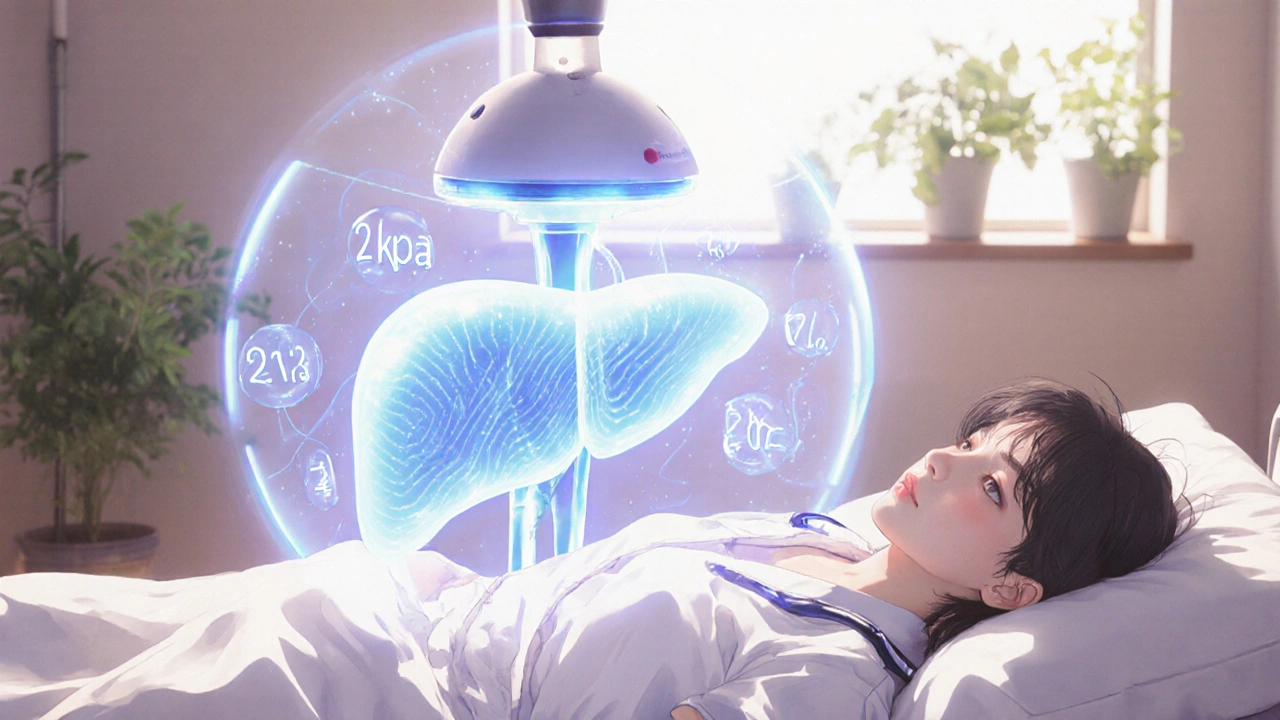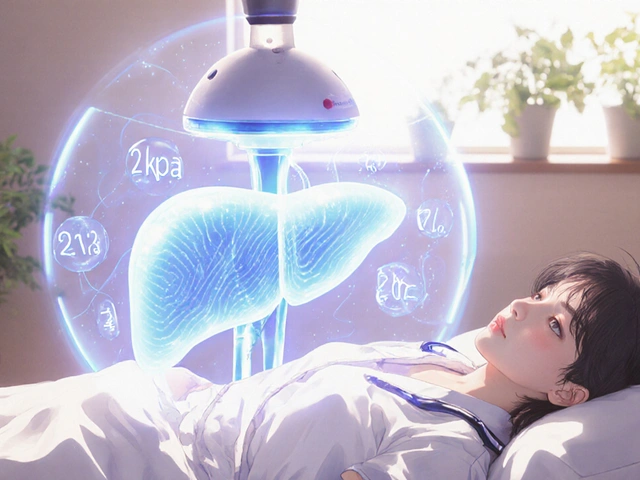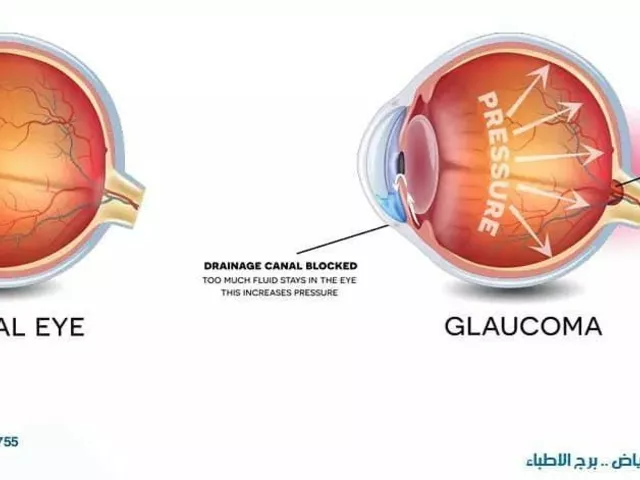When your doctor suspects liver damage, you might expect a needle going into your liver. But that’s not the only option anymore. In fact, most people with fatty liver disease or hepatitis don’t need a biopsy at all. Thanks to advances in medical technology, doctors can now check for liver scarring-called fibrosis-using simple, painless tests. Two main types are now widely used: FibroScan and serum-based scores like FIB-4, APRI, and ELF. These tools help avoid risky procedures, catch problems early, and guide treatment without cutting into the body.
What FibroScan Actually Measures
FibroScan is a handheld device that looks like an ultrasound machine but works differently. Instead of sound waves, it sends low-frequency vibrations-called shear waves-through your skin and into your liver. These waves travel faster when the liver is stiff from scar tissue. The machine measures how fast they move and gives you a number in kilopascals (kPa). Normal liver stiffness is between 2 and 7 kPa. Anything above 7.1 kPa suggests early fibrosis. Above 12 kPa usually means advanced scarring, and over 14 kPa often points to cirrhosis.
The device has two probes: one for average-sized people (S probe) and a larger one (XL probe) for those with higher body weight or more fat around the liver. If you have a BMI over 28 or your fat score (CAP) is above 268 dB/m, the XL probe is needed. Without it, results can be wrong. Many patients don’t know this-some have had multiple failed attempts before being switched to the right probe.
FibroScan also measures fat in the liver using CAP (Controlled Attenuation Parameter). A score of 238-260 dB/m means 11-33% fat, 260-290 dB/m means 34-66%, and above 290 dB/m means over two-thirds of the liver is fatty. That’s important because most people with liver fibrosis also have fatty liver disease. But here’s the catch: CAP overpredicts fat in obese patients. One study found that 81% of people with mild fat on biopsy were labeled as having severe fat by CAP. That’s why doctors don’t rely on CAP alone.
How Serum Scores Work (FIB-4, APRI, ELF)
Serum scores are blood tests you’ve probably already had. No special visit, no machine, no waiting in a clinic. They use routine numbers from your blood work: AST, ALT, platelets, age, and sometimes glucose. The most common one is FIB-4. You plug those numbers into a simple formula, and it gives you a risk score.
FIB-4 above 2.67 means high risk for advanced fibrosis. Below 1.3 means you’re very unlikely to have serious scarring. That’s powerful. It means if your FIB-4 is low, you might not need any further testing. In fact, studies show FIB-4 has a 90% negative predictive value-meaning if it says you’re fine, you almost certainly are.
APRI is simpler. It uses just AST and platelets. A score above 2.0 suggests cirrhosis. It’s less accurate than FIB-4 but cheaper and easier to calculate. ELF is more complex. It measures three proteins linked to liver scarring: hyaluronic acid, procollagen III peptide, and tissue inhibitor of metalloproteinases-1. It’s more expensive than FIB-4, but it’s better at catching early fibrosis and works well in obese patients.
The big advantage of serum scores? They’re built into electronic health records. One primary care doctor in Pennsylvania said her clinic went from screening 12% of at-risk patients to 67% after FIB-4 became automatic in their system. No extra steps. No extra cost. Just a number that pops up when your blood results come in.
Which Test Is More Accurate?
Here’s where it gets messy. FibroScan sounds like the gold standard, but it’s not perfect. A 2023 study found it only correctly flagged 45.9% of patients with advanced fibrosis (F3/F4). That means more than half of the people with serious scarring were told they were fine. That’s a big problem.
Meanwhile, FIB-4 only caught 16.8% of those same cases. That sounds terrible-but it’s not meant to be a diagnostic tool. It’s a filter. Its strength is ruling things out. If your FIB-4 is low, you’re almost certainly not in danger. If it’s high, then you need FibroScan or something else to confirm.
For cirrhosis (F4), FibroScan is excellent. One study showed a 0.99 accuracy rate. That’s nearly perfect. But for early or moderate fibrosis (F2/F3), it’s hit or miss. That’s why experts say: don’t use one test alone. Use them together.
ELF scores are better than FIB-4 at detecting early fibrosis, especially in people with diabetes or obesity. But they cost $100-$200 per test, while FIB-4 costs about $10. Insurance usually covers FIB-4 because it’s calculated from existing blood work. ELF often doesn’t.
When FibroScan Fails
FibroScan isn’t magic. It can give false results if you’ve eaten in the last 3 hours, if you have an active liver infection (like hepatitis flare), or if you have heart failure. Acute inflammation can make your liver stiffness number jump even if you don’t have more scarring.
Technical failures happen too. About 10-15% of tests are inconclusive. That’s because the probe can’t get a good signal through thick fat or muscle. One patient on Reddit said he had three failed attempts before they used the XL probe-and it added $200 to his bill. Not every clinic has the XL probe. Not every provider knows when to use it.
Operator skill matters. The American Society of Gastrointestinal Endoscopy recommends 50 supervised scans before someone can use the machine independently. Many clinics don’t have that level of training. That’s why results vary so much between hospitals.
How Doctors Use These Tests Together
The European Association for the Study of the Liver (EASL) has a clear protocol:
- Start with FIB-4. If it’s below 1.3, you’re low risk. No further testing needed.
- If it’s above 2.67, you’re high risk. Go straight to FibroScan.
- If it’s between 1.3 and 2.67, you’re in the gray zone. Do FibroScan.
- If FibroScan and FIB-4 disagree, use ELF as a tiebreaker.
- Only do a biopsy if results still don’t match or if something else looks suspicious.
This approach cuts biopsy rates by 70%. That’s huge. Biopsies carry small but real risks: bleeding, infection, even death in rare cases. Avoiding them isn’t just more comfortable-it’s safer.
A 2023 NIH pilot program tested a three-test algorithm: FIB-4, FibroScan, and ELF. It reduced unnecessary biopsies by 82% while still catching 94% of cirrhosis cases. That’s the future: combining tools to get it right, not just picking one.

What’s New in 2025
The latest FibroScan model, the 730, came out in April 2024. It uses AI to judge whether a reading is reliable. It flags shaky data before the doctor even sees it. Early trials show it cuts technical failures by 22%.
There’s also a new serum score called FIB-5. It adds glucose levels to the FIB-4 formula. It’s especially useful for people with diabetes, who are at higher risk for fast-progressing liver disease. In a March 2024 study, FIB-5 caught 89% of advanced fibrosis cases in diabetic patients-better than FIB-4 alone.
MRI-based elastography (MRE) is more accurate than FibroScan, with 95% sensitivity for early fibrosis. But it costs 10 times more, takes longer, and isn’t available in most clinics. Smartphone apps like HepaTouch are being tested, but they’re still experimental. No one’s using them in real practice yet.
What You Should Do If You’re At Risk
If you have obesity, type 2 diabetes, high cholesterol, or a history of heavy drinking, ask your doctor for a FIB-4 test. It’s probably already in your blood work. If it’s low, you’re likely fine. If it’s high, ask for a FibroScan. Don’t panic if your numbers don’t match. That’s normal. Ask for a second test or an ELF if needed.
Don’t let cost stop you. FIB-4 costs less than a coffee. FibroScan runs $50-$150, but insurance often covers it if you’re high risk. Medicare and Medicaid reimburse around $55 per scan. If your doctor says you don’t qualify, ask for a referral to a liver specialist. NAFLD affects 1 in 4 adults in the U.S. Most don’t know they have it until it’s advanced.
And remember: no test is perfect. A patient once told me, “My FibroScan said F2, FIB-4 said high risk, and the biopsy showed F3.” Both tests were wrong. But the biopsy caught it. That’s why clinical judgment still matters. Your doctor needs to know your full story-your weight, your drinking, your meds, your family history. Numbers help. They don’t replace you.
Bottom Line
FibroScan and serum scores aren’t competitors. They’re teammates. FIB-4 is your first filter. FibroScan is your second look. ELF is your backup when things get unclear. Together, they’re changing how we catch liver disease-before it turns into cancer or cirrhosis. You don’t need a needle. You just need to ask the right questions.
Is FibroScan better than a liver biopsy?
FibroScan is safer and less painful than a biopsy, and it’s just as accurate for detecting cirrhosis. But for early or moderate fibrosis, it can miss cases. Biopsies are still the most detailed view of liver tissue, but they’re invasive and carry small risks. Most doctors now use FibroScan first and only do a biopsy if results are unclear or conflicting.
Can I get a FibroScan at my regular doctor’s office?
Some primary care clinics have FibroScan machines, especially those that treat a lot of patients with fatty liver disease. But most often, you’ll be referred to a gastroenterologist, hepatologist, or imaging center. Ask your doctor if they offer it-or if they can refer you to a nearby location. Not every clinic has the XL probe, so make sure they know how to use it properly.
How often should I get tested for liver fibrosis?
If you’re at risk-overweight, diabetic, or have fatty liver-get tested once a year. If your first test shows no fibrosis and you’re making lifestyle changes (losing weight, cutting sugar, exercising), you might wait two years. If you have early fibrosis, your doctor will likely want to retest every 6-12 months to see if it’s getting worse.
Do I need to fast before a FibroScan?
Yes. You should avoid eating or drinking anything except water for at least 3 hours before the test. Food and drinks can make your liver temporarily stiffer, which can give a false high reading. Also, avoid alcohol for 24 hours before the test. These steps help make sure the result is accurate.
Why does my FIB-4 keep changing?
FIB-4 uses your age, AST, ALT, and platelet count. If your liver enzymes go up after drinking alcohol, getting sick, or taking certain meds, your FIB-4 will rise-even if your scarring hasn’t changed. That’s why it’s not a standalone diagnosis. It’s a trend tool. Look at how your score changes over time, not just one number. A rising FIB-4 over months is more concerning than a single high number.
Can I reverse liver fibrosis?
Yes, especially in early stages. Losing 7-10% of your body weight, cutting out sugary drinks, exercising regularly, and avoiding alcohol can reduce liver scarring. Studies show that people with NAFLD who lose weight can reverse fibrosis by one stage in just one year. The earlier you act, the better your chances. Even if you have advanced fibrosis, stopping the cause (like alcohol or diabetes) can slow or stop further damage.








Katelyn Sykes November 17, 2025
I got my FibroScan last year and they used the S probe first - failed three times. Then switched to XL and boom, perfect reading. No one told me about the probe difference until I complained. Seriously, ask for XL if you're overweight.
Sarah Frey November 17, 2025
I appreciate how this breaks down the science without jargon. As a nurse, I've seen too many patients panic over a single FIB-4 number. The key is trends, not snapshots. One high number doesn't mean cirrhosis. It means check again in six months with lifestyle changes.
Gabe Solack November 18, 2025
ELF is the real MVP for obese patients 🙌 I had a patient with BMI 42 whose FIB-4 kept jumping but ELF stayed low. Turned out her liver enzymes were spiked from statins, not fibrosis. Saved her from unnecessary stress and a scan. Doctors need to know this stuff.
Yash Nair November 20, 2025
this is just big pharma bs to sell machines and blood tests. in india we just use herbs and fasting. why pay 200 dollars for a scan when turmeric works better? they dont want you to know the truth. doctors are paid by the system to scare you into tests
Bailey Sheppard November 22, 2025
I was skeptical at first but after my doctor used the FIB-4 + FibroScan combo, I realized how much better this is than a biopsy. My number was borderline, so we did both. They matched. No needle, no downtime. Just a quick scan and a blood draw I already had. Life changing for people like me who hate needles.
Kristi Joy November 22, 2025
If you're reading this and you're overweight or diabetic, please don't ignore your liver. I had NAFLD for years and thought it was just "fat guy stuff." Then my FIB-4 came back high and I finally took action. Lost 22 pounds, cut out soda, started walking. My last scan showed improvement. It's not hopeless. Small changes matter. You've got this.
Louie Amour November 22, 2025
Honestly, this whole article is just a glorified ad for FibroScan. Real hepatologists still rely on biopsy. The AI in the new model? It's just masking poor training. If your clinic doesn't have a certified operator, you're getting garbage data. Don't be fooled by shiny tech. The old ways still win when it matters.
Kristina Williams November 23, 2025
they dont want you to know but fibroscan is linked to 5g towers. the vibrations interfere with your cells and make the liver look scarred even when its not. the government and big pharma use this to make people pay for fake treatments. my cousin got a high reading and then her phone died and she got a second scan and it was normal. coincidence? i think not.